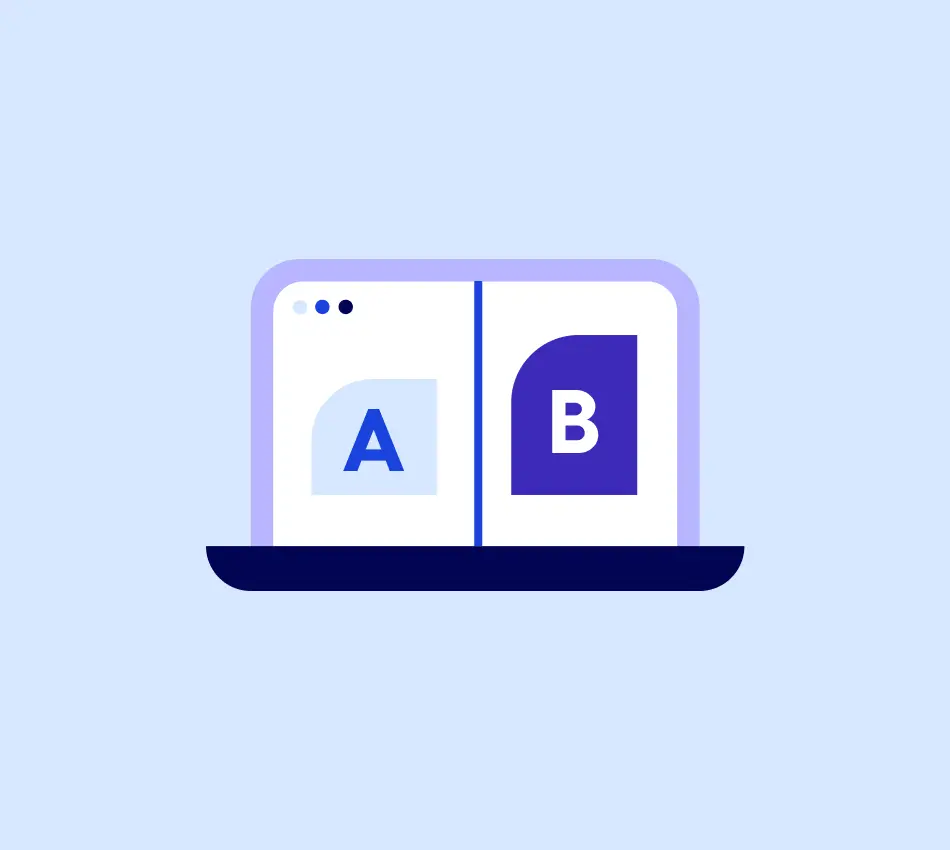Web design and content creation are expensive. Marketing campaigns can cost thousands of dollars. Without proper research, companies targeting diverse audience segments can spend far more than is necessary on customer acquisition. Fortunately, there are methods to help spot strengths and issues with your strategy early, and one of them is A/B testing.
What is A/B testing?
An A/B test is a simple user experience research technique, a randomized test in which you present two different versions of a product to two different groups. You can use this technique to test proposed updates to web pages, app screens, email subject lines, or any other marketing or product updates.
For example, let’s say you want to test the location of the shopping cart on your website. At random, your sample size is split into two groups, A and B. Group A is shown a control (the current page) and group B is shown the variant. You can then collect and analyze the data from each group to inform your next design decision.
What can you A/B test?
Anything customer-facing can be A/B tested, including marketing campaigns or materials. Some specific examples include:
- Design/layout: As the years pass, your web design may grow stale or dated. Try running a variation to see if your conversion rate improves. If launching a new website, test two or more versions.
- Imagery/photography: Customers respond to strong images even when they don’t read the caption—after all, a picture is worth a thousand words. Test different photos and images to measure how well they hold attention or drive clicks.
- Headlines: Test different headlines on copy and web pages to see which holds customer attention beyond their first seconds on a page.
- Body copy: Before reading, the shape of your body copy is the first thing visitors will see. Generally, use shorter paragraphs, bullet points, bolded words and phrases, and other skimmable text to capture attention.
- Navigation: Your navigation bar should be easy to find and navigate, both on web and mobile. Consider which parts of your user interface should be on the side versus the top.
- User flow: Conduct an A/B test to track the journey a user takes on or through your website—simplify and eliminate steps to retain and attract customers. For example, you can test the checkout process on your ecommerce site to reduce cart abandonment.
- Form fields: Try to reduce the number of form fields you need from customers as much as possible, and label each field clearly so the user knows what to enter.
- Calls to action: Test the position and wording of your calls-to-action. See which design and part of the page leads to the most clicks.
- Subject lines: As a marketer, you should frequently test new email subject lines. Poor subject lines can burn out a prospect, so test different styles of communication within your brand voice.
What can A/B testing help measure?
You’ll need to target specific metrics when analyzing your A/B test results, so make sure you have a web analytics program that can track page views, conversions, exit rates, and bounce rates (plus cart abandonment rate if you’re an ecommerce business). For emails, track open rates and click-through rates.
Why you should consider A/B testing
Increase ROI from current visitors
With an A/B test, you can figure out solutions to your customers’ pain points and increase revenue from customers you’ve already attracted. For example, how many of your visitors abandon their filled carts? Test a new user flow that consolidates steps or otherwise removes friction. This can help increase customer lifetime value.
Lower bounce rates
Do visitors bounce out of your website seconds after they arrive? Some of them could be bots, but others aren’t seeing what they need to right away. Test variations of your web pages with the highest bounce rates.
Address pain points
By understanding where users get stuck in their journeys, you can resolve pain points individually through a strategic A/B testing plan. Start at the bottom of the funnel and work your way up to reduce friction throughout the process.
Make minor changes for major results
Modifying seemingly small aspects of your site or user experience—like changing the position of a call-to-action or eliminating a step in the purchase process—can improve your conversion rates dramatically.
How to implement A/B testing
1. Collect data
When choosing A/B testing tools, list what you want to test and the metrics that measure them. Use software or other tools to collect the data you’re going to analyze.
2. Create a hypothesis and plan
Define the metrics and objectives you want to address and select benchmarks for success. This step also involves setting the test duration and your testing methodology.
3. Develop variations to test
Create one or multiple versions to test against your control. Focus on one variable at a time, as making multiple changes simultaneously will obscure which factors influenced your target audience’s response.
4. Run your A/B test
Gather results using tools that compare your variants against your control. By this point, you should be familiar with these tools, but remain open to switching if they’re not meeting your needs.
5. Determine a winner
Analyze how your variants performed against the control to determine whether it’s worth implementing a change. If the difference is slight, test new variations to gather more data—A/B testing is an iterative process.
One important thing to remember about A/B testing
Test one variable at a time. For example, if you want to A/B test the design of a web page, keep the copy the same, and vice versa. That way, you’ll get clearer results from a true test instead of muddying the waters with multiple variables.
Budget better for A/B testing with sub-accounts.
